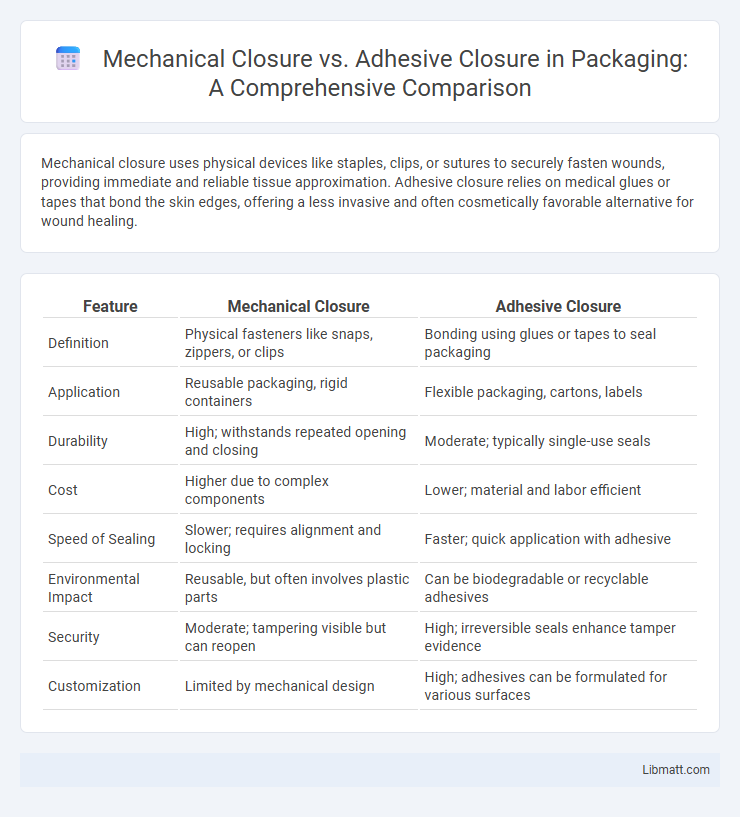Mechanical closure uses physical devices like staples, clips, or sutures to securely fasten wounds, providing immediate and reliable tissue approximation. Adhesive closure relies on medical glues or tapes that bond the skin edges, offering a less invasive and often cosmetically favorable alternative for wound healing.
Table of Comparison
| Feature | Mechanical Closure | Adhesive Closure |
|---|---|---|
| Definition | Physical fasteners like snaps, zippers, or clips | Bonding using glues or tapes to seal packaging |
| Application | Reusable packaging, rigid containers | Flexible packaging, cartons, labels |
| Durability | High; withstands repeated opening and closing | Moderate; typically single-use seals |
| Cost | Higher due to complex components | Lower; material and labor efficient |
| Speed of Sealing | Slower; requires alignment and locking | Faster; quick application with adhesive |
| Environmental Impact | Reusable, but often involves plastic parts | Can be biodegradable or recyclable adhesives |
| Security | Moderate; tampering visible but can reopen | High; irreversible seals enhance tamper evidence |
| Customization | Limited by mechanical design | High; adhesives can be formulated for various surfaces |
Introduction to Wound Closure Techniques
Wound closure techniques play a critical role in surgical outcomes by promoting healing and minimizing infection risks. Mechanical closure uses sutures, staples, or clips to physically approximate wound edges, providing strong and reliable support for tissue repair. Adhesive closure employs medical glues or tapes, offering a less invasive alternative that reduces scarring and suits smaller or superficial wounds, making it important to choose the method best aligned with Your wound type and healing needs.
What is Mechanical Closure?
Mechanical closure refers to the use of physical devices such as sutures, staples, or clips to close wounds or surgical incisions, providing secure tissue approximation. These methods ensure precise alignment and tension control, promoting optimal healing and minimizing the risk of wound dehiscence. Mechanical closures are widely utilized in various medical and surgical procedures due to their reliability and ease of application.
Understanding Adhesive Closure Methods
Adhesive closure methods utilize medical-grade glues or tapes to seal wounds, providing a less invasive alternative to mechanical closure techniques like sutures or staples. These adhesives promote faster healing, reduce infection risk, and minimize scarring by bonding skin edges without puncturing the tissue. Understanding adhesive closure methods helps you choose the optimal wound care that ensures comfort and efficient recovery.
Comparative Effectiveness: Mechanical vs Adhesive Closure
Mechanical closure techniques, such as sutures and staples, provide strong wound approximation with advantages in tension-bearing areas and typically offer greater tensile strength. Adhesive closures, including tissue glue and skin adhesives, promote faster application, reduced scarring, and lower infection rates by forming a microbial barrier. Clinical studies indicate mechanical closure is preferred for high-stress wounds, while adhesive closure is optimal for smaller, low-tension incisions, enhancing cosmetic outcomes and patient comfort.
Healing Outcomes and Scar Appearance
Mechanical closure methods such as sutures and staples provide precise wound edge approximation, promoting consistent tensile strength and typically resulting in reduced wound dehiscence and improved healing outcomes. Adhesive closure techniques like tissue glues create a flexible, waterproof barrier that allows for less tissue trauma and minimal inflammation, often leading to finer, less noticeable scars. Studies comparing both methods demonstrate that while mechanical closures may offer superior control in deep or high-tension wounds, adhesives tend to yield better cosmetic results in superficial lacerations due to reduced skin trauma and inflammation.
Infection Risks and Complication Rates
Mechanical closures, such as staples and sutures, are associated with a higher risk of surgical site infections (SSI) compared to adhesive closures, primarily due to increased tissue trauma and greater foreign body presence. Adhesive closures, including medical-grade cyanoacrylate glues and adhesive strips, demonstrate lower complication rates by providing a microbial barrier and reducing wound exposure to environmental contaminants. Studies indicate that adhesive closures result in fewer wound dehiscence and inflammation cases, leading to improved healing outcomes and decreased postoperative infection rates.
Patient Comfort and Procedure Time
Mechanical closure methods, such as sutures and staples, often require more time to apply and can cause increased discomfort during removal, impacting overall patient comfort. Adhesive closures, including medical glues and tapes, provide a quicker application process and minimize pain since they do not need removal, enhancing patient satisfaction. Your choice between these options should consider the balance between procedure time efficiency and the comfort level expected during healing.
Cost Analysis: Mechanical vs Adhesive Closure
Mechanical closure methods, such as staples and sutures, generally incur lower upfront costs compared to adhesive closures, which often require specialized products with higher price points. However, adhesive closures can reduce overall expenses by minimizing wound complications and shortening procedure times, leading to faster patient recovery and fewer follow-up visits. Your choice between mechanical and adhesive closure should weigh initial costs against long-term savings and patient outcomes.
Best Practices for Selecting Closure Methods
Selecting the appropriate closure method depends on factors such as wound type, location, and healing requirements. Mechanical closures like sutures and staples provide strong, reliable wound edge approximation ideal for high-tension areas, while adhesive closures offer a less invasive option suited for minor, low-tension wounds. Your decision should balance infection risk, cosmetic outcomes, and patient comfort to ensure optimal healing and usability.
Future Trends in Wound Closure Technology
Future trends in wound closure technology emphasize the integration of smart adhesives with bioactive components that promote faster healing and reduce infection risks. Mechanical closures like staples and sutures are evolving with the incorporation of biodegradable materials that minimize tissue trauma and eliminate the need for removal. Advances in nanotechnology and tissue engineering are driving the development of hybrid closure systems combining mechanical strength with the flexibility and biocompatibility of adhesives.
Mechanical closure vs adhesive closure Infographic

 libmatt.com
libmatt.com